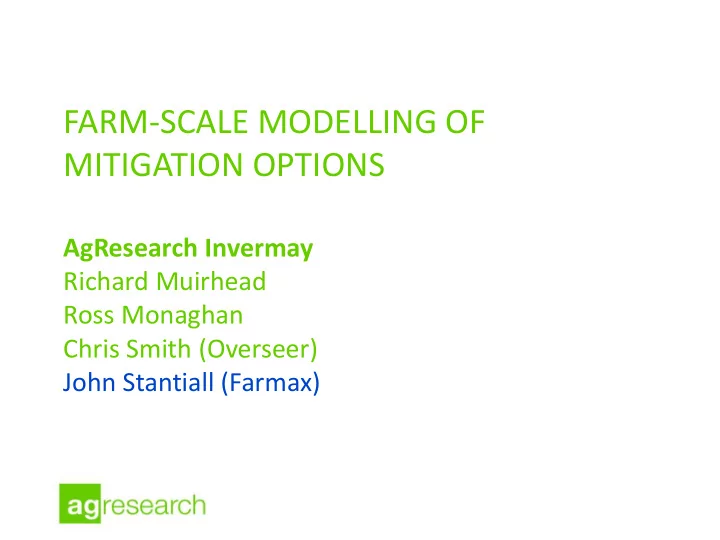

FARM-SCALE MODELLING OF MITIGATION OPTIONS AgResearch Invermay Richard Muirhead Ross Monaghan Chris Smith (Overseer) John Stantiall (Farmax)
The Economic Modelling Process OUTPUTS Mitigation Catchment Aggregated farming OUTPUTS Modelling Economic income and costs of Model Cost per year to mitigation at different Choose implement each scales: mitigation Integrate mitigation ‘bundle’ • On-farm bundles outputs from • Multiple farms mitigation • Whole-of-catchment Set up models modelling and Estimate of biophysical Work out the cheapest effectiveness models way to achieve specific (% reduction of Model impacts outcomes each contaminant, of mitigations Based on e.g. N, P, sediment) on 16 NZFARM Impacts of policies on representative (Landcare land use farms in Research) Farmax and Test different policy Overseer approaches www.mpi.govt.nz • 3
FARM-SCALE MODELLING What you selected to model 1. Current policy 2. Easy + Medium GMP options 3. Hard GMP options What happened since then? MPI provided AgResearch with the Overseer and Farmax files for the 16 base farms And then we got going!
MODELLING PROCESS Models used Overseer for N and P losses Manuel calculations for Sediment and E. coli Farmax for production and profit High level stuff Changes in area of farm blocks adjusted (FDE irrigation, Wetlands, Riparian) Loss of production areas accounted for by reducing stock numbers Assumed 26m of stream per ha of land Wetland area = 1% of catchment size. Changes in fertilizer checked for maintaining animal feed production Changes in farm costs in farmax (inc. labour) Capital costs annualized over 25 years
EACH FARM IS DIFFERENT Only applied the mitigations that fitted for each farm Only applied to part of the farm Some mitigations were already applied on all farms (fencing) Some mitigations were not applied to any farms (1) Did not have enough information (diverting laneway runoff) (2) Mitigations targeted the same source and pathway (Sed traps & “split grass/clover”) (3) Too small to justify the effort (off pasture systems) However – unlikely to have significant effect overall (<1%)
DAIRY FARMS M1 - FDE low rate application and storage ponds (Massey pond storage calculator) M2 - Installed centre pivot irrigators - Managed irrigation to best practice (soil water balance) - Increased FDE irrigation areas (equipment) - Reduced N fertilizer (P21 research) - Reduced P fertilizer (temporarily: averaged over 25 years) - Changed from imported barley to low N maize - Installed a wetland (on a hill block – not flat land) - Changed from imported silage to low N maize M3 – Applied planted riparian buffer strips (not to well drained soils)
DAIRY FARMS – CUMULATIVE % CHANGE Farm Profit Nitrogen Phosphorus Sediment E. coli M1 M2 M3 M1 M2 M3 M1 M2 M3 M2 M3 M1 Low Rain, -1 -18 -24 2 -45 -42 10 -10 -20 0 -8 -28 High Prod. Low Rain, -2 -21 -24 -6 -24 -24 -13 -7 -7 -19 -72 -28 Mod. Prod. Mod. Rain -2 -5 -12 0 -8 -8 0 -17 -17 0 -65 -28 High Rain -2 -17 -22 -2 -11 -11 -6 -6 -6 -22 -39 -21 Irrigated -1 4 -1 0 -21 -17 0 -11 -11 0 -65 -28 Organic -1 -6 -7 3 -51 -51 0 -38 -38 0 -22 -21
SHEEP & BEEF FARMS M1 - Nothing M2 - Changed P fertilizer to RPR (sloping land) - installed wet lands - CSA protection of winter forage grazing - earlier reestablishment of pasture after cropping - Reduced P fertilizer (temporarily: averaged over 25 years) - Installed centre pivot irrigators - Managed irrigation to best practice (soil water balance) - Reduced N fertilizer inputs M3 - Applied planted riparian buffer strips (not to well drained soils)
SHEEP & BEEF FARMS – CUMULATIVE % CHANGE Farm Profit Nitrogen Phosphorus Sediment M2 M3 M2 M3 M2 M3 M2 M3 Dry, -16 -25 -10 0 0 -50 -18 -52 finishing Wet, -17 -25 -9 -9 0 -78 -27 -50 breeding Wet, -20 -25 -10 -10 -20 -82 -13 -54 finishing S&B -31 -47 -11 -11 -22 -56 -10 -38 finishing Irr. S&B -18 -27 -20 -20 -33 -56 -21 -33 trading Trading, -7 -12 -20 -20 -17 -17 0 0 20% crop Breeding -20 -31 0 0 0 -50 -19 -52 Sum. Dry
DAIRY SUPPORT FARMS M1 - Nothing M2 - CSA protection of winter forage grazing - Earlier reestablishment of pasture after cropping - Reduced N fertilizer inputs M3 - Applied planted riparian buffer strips (not to well drained soils)
DAIRY SUPPORT FARMS – CUMULATIVE % CHANGE Farm Profit Nitrogen Phosphorus Sediment M2 M3 M2 M3 M2 M3 M2 M3 Fin. Beef + -34 -46 -5 -5 0 -20 0 -33 65% crop Dairy S. 0 0 -7 -7 0 0 0 0 15% crop, sum. dry Dairy S. -6 -15 -27 -27 -10 -30 -17 -44 48% crop, sum. wet
SUMMARY N reductions in the 0 – 45% range P reductions in the 0 – 82% range Sediment reductions in the 0 – 72% range E. coli reductions in the 21 – 28% range on Dairy Farms only Profit changes in the +4 to -47% range Data can be used to generate cost abatement curves
COST ABATEMENT CURVE
Recommend
More recommend